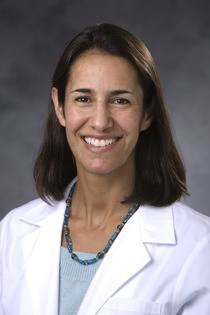
Daniella Zipkin, MD
2015 has been a whirlwind year for Daniella Zipkin, MD. In addition to her normal duties, Zipkin contributed to four sessions at this year’s SGIM meeting in Toronto in April. This summer she also will be taking on the role of Associate Program Director for the division’s residency program in ambulatory care. In this week’s faculty spotlight, Zipkin talks about her experience in Toronto, her new role in ambulatory care, and snowboarding in the Rocky mountains. She also offers advice for how medical educators can get noticed and promoted in academia.
How long have you been at Duke? How long have you been at the division?
I came to both Duke and the division in 2007.
What are your responsibilities within the division? What does a typical day for you look like?
My days vary a lot, so it’s hard for me to list a typical day. A typical week may be easier. That includes clinical primary care, a lot of supervising residents in clinic, and a fair amount of academic time, such as building and planning curricula. I also teach a curriculum on evidence-based medicine to our residents about ten months out of the year, in a one-week chunk. In some of the spare time that’s left I plan talks to deliver at Duke and nationally. I just finished a five-year stint on the Evidence-Based Medicine Task Force for SGIM.
I’m also very excited because my job description is about to change. Starting in July I’m going to become the Associate Program Director for our residency program in ambulatory care. I’ll be taking over the role that Alex Cho currently holds. I’ve worked with him on several projects for the past two years, including the Ambulatory Care Leadership Track, so it should be a smooth transition. I can’t wait to take on a bigger role in the residency program.
You’ve been involved with that program for a while now. How did that begin, and how has it evolved since then?
The Ambulatory Care Leadership Track was first conceived by Larry Greenblatt, and it is now finishing its third year. Over the past two years it’s been further developed by Alex Cho, who brought me on to co-direct.
Dr. Cho and I were both residents at NYU primary care, and we brought some of our experience there to the program. The curriculum we offer has four arms: clinical, teaching, scholarship, and advocacy. The clinical arm offers a variety of clinical experience in dermatology, gynecology, orthopedics and other areas that make up the breadth of general internal medicine. The scholarship arm offers support in scholarly projects as well as a running journal club that the residents do as a group. The teaching arm involves a curriculum for learners-as-teachers led by Drs. Chudgar and Greenblatt, with the residents then leading their own teaching sessions for their peers each year.
Finally, our advocacy arm is the most unique and visible aspect of the program, where we forge connections with government leaders and give the residents an opportunity to interface with legislators and advocate for issues they care about. In early blocks the residents learn legislative issues and models of care, and over the course of the year they develop their own platform and meet with leaders at the state or national level. We alternate visits every year – we went to Raleigh early this March, and next year, we’ll go back to Washington, DC. It’s really a rich experience that expands medical training to domains programs don’t traditionally cover.
You contributed to four sessions at this year’s SGIM meeting in Toronto. What experiences stood out the most for you?
Two of the sessions that were related to a 2014 systematic review I published on risk communication definitely stand out. We looked at the interface of clinical guidelines and shared decision making in one workshop, and the overlap of evidence-based medicine with high value care in another.
Another great session that I led together with Ebony Boulware addressed getting promoted as an educator. We had a chance to engage a small group to talk about how faculty can promote themselves and show off their work in a productive way.
Do you have any tips for how educators can get noticed for their work?
It’s a challenging area because educators often end up as the lost arm of the academic medical center. Many academic medical centers are ill-equipped to define the academic productivity of educators or find financial support for their time. Over time, promotions criteria have been very well defined for clinicians and researchers, but not as much for educators.
I would offer educators this advice: Figure out what you love and get creative in teaching it. Get in front of learners and show off your stuff. Advocate for yourself. Invite your faculty peers, or your boss, to watch you teach! In truth, you might have to do it “for free” at first, and then earn the support of your program or division. There are many more steps when it comes to promotion – folks can email me if they want to talk more!
What passions or hobbies do you have outside of the division?
Throughout all of this, I’ve never compromised on family time. I love being with my husband and two little girls more than anything! I am also really into fitness and exercise. My biggest passion is snowboarding, and my girls are skiers too. We make at least one trip to the Rockies each year. (I wrote that into the contract when we moved to North Carolina!) In other rare moments of spare time I play beach volleyball. As a foodie I also enjoy eating fancy stuff at amazing restaurants throughout the Triangle.

